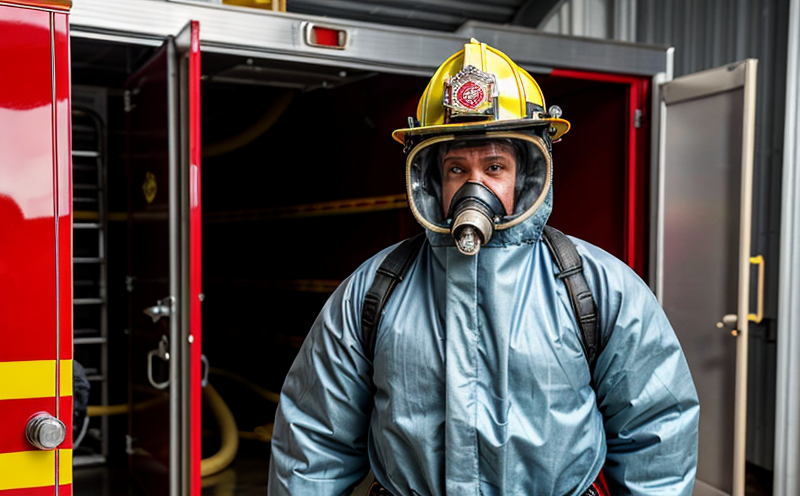Firefighter Equipment Thermal Aging Testing
Thermal aging testing is a crucial component of ensuring that firefighter protective clothing and equipment (PPE) remain effective and safe under the extreme conditions they are subjected to. This type of testing evaluates how materials used in PPE degrade over time when exposed to high temperatures, simulating real-world scenarios where firefighters operate in intense heat and flame.
The primary objective is to determine the thermal stability and durability of critical components such as turnout gear, gloves, boots, and helmets. By conducting these tests, we ensure that the PPE continues to provide adequate protection against heat, flames, and other thermal hazards throughout its service life. This testing helps in maintaining compliance with international standards like NFPA 1971, which sets performance requirements for structural fire fighters' protective clothing.
During thermal aging tests, samples of the PPE are subjected to controlled environments that mimic the heat exposure experienced by firefighters during operations. The test parameters include temperature ranges typically exceeding 300°C (572°F) and durations that can last several days or weeks depending on the material's specifications. Specimens must undergo rigorous conditioning before testing, including cleaning methods specific to each type of fabric used in the equipment.
Once prepared, samples are placed into ovens equipped with temperature control systems capable of maintaining precise conditions within specified tolerances. These tests assess not only the physical integrity but also the thermal resistance and flame retardancy properties of the materials. After exposure, samples are inspected for signs of damage or deterioration such as melting, burning, or loss of structural strength.
The results from these tests play a vital role in product development processes by identifying any weaknesses early on so manufacturers can address them before releasing products into marketplaces. Additionally, they serve as valuable data points during regulatory submissions proving that newly developed or modified PPE meets all necessary safety standards.
Why It Matters
The importance of thermal aging tests cannot be overstated when it comes to protecting firefighters' lives and health. Firefighting is one of the most dangerous professions, with hazards like intense heat, flames, smoke inhalation, and toxic chemicals posing significant risks even during training exercises. Properly conducted thermal aging tests help ensure that firefighting equipment remains effective under these challenging conditions.
- Enhances Safety: Ensures PPE continues to provide reliable protection against extreme temperatures.
- Improves Durability: Identifies potential weaknesses in material performance over time, enhancing longevity and reliability.
- Compliance Assurance: Helps manufacturers meet stringent regulatory requirements set by organizations like NFPA 1971.
- Informs Product Development: Provides critical feedback on product design improvements needed for better overall performance.
The ultimate goal is to create safer, more durable PPE that can withstand the rigors of firefighting duties without compromising effectiveness. By prioritizing thermal aging tests as part of comprehensive quality assurance programs, organizations contribute significantly towards improving public safety and reducing risks associated with fire service activities.
Why Choose This Test
- Accurate Representation: Our state-of-the-art facilities replicate actual field conditions, ensuring accurate results reflective of real-world performance.
- Comprehensive Coverage: We test various types of PPE including turnout gear, gloves, boots, and helmets using industry-standard methodologies.
- Expertise: Our team comprises seasoned professionals with extensive experience in fire science and materials engineering.
- Regulatory Compliance: Ensures that all tests comply with relevant international standards like NFPA 1971, providing peace of mind regarding regulatory adherence.
Choose us for your thermal aging testing needs because we combine cutting-edge technology with meticulous attention to detail. Your success is our priority, and we are committed to delivering accurate, reliable results that meet or exceed expectations.
Environmental and Sustainability Contributions
In addition to enhancing safety and performance of firefighting equipment, thermal aging testing also plays a role in promoting sustainability within the fire service. By identifying materials that maintain their integrity over extended periods without compromising on quality, we contribute positively towards reducing waste associated with frequent replacement due to failure.
Through our rigorous testing protocols, we help manufacturers select eco-friendly alternatives when possible while ensuring they do not sacrifice on essential safety features. This approach fosters a balance between environmental responsibility and operational efficiency, ultimately leading to more sustainable practices within the fire service sector.
Beyond immediate benefits for firefighters, these efforts also have broader implications for reducing carbon footprints across industries involved in producing protective gear. By optimizing material choices based on robust testing data, we contribute significantly towards creating a greener future while maintaining high standards of occupational safety.





